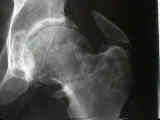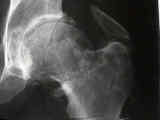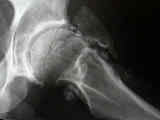Discussion
- a monarticular synovial proliferative disease which is characterized by the metaplastic conversion of cartilagenous tissue to ossified loose bodies;
- cartilagenous or osteocartilaginous metaplasia takes place w/in the synovial membrane of joints, bursae, or tendon sheaths;
- seen most often in middle-aged men;
- pts report pain and limitation of motion;
location
- over one-half of cases occur in the knee, followed by the elbow;
- other common sites include the hip, shoulder, wrist and ankle;
- when located in the foot or ankle the term "soft tissue chondroma" may be used;
classification
- early: no loose bodies but active synovial disease;
- transitional: active synovial disease, and loose bodies;
- late: loose bodies but no synovial disease;
diff dx
- hemangioma
- tumoral calcinosis
- soft tissue chondroma
- dermatomyositis
- hyperparathyroidism
- hypervitaminosis D
- idiopathic hypercalcemia
Radiographs
- intraarticular loose bodies are seen in > 70%;
- when radiographs are negative, MRI may show cartilagenous bodies;
- MRI will show high signal on T2 weighted images;
Treatment
- total open synovectomy is the treatment of choice;
- recurrence rate is over 25%
References
- Extra-articular synovial chondromatosis.
- Synovial osteochondromatosis: a histopathological study of thirty cases.
- Primary synovial chondromatosis of the ankle. A case report.
- Generalized synovial chondromatosis of the knee: A comparison of removal of the loose bodies alone with arthroscopic synovectomy.
- Surgery for synovial chondromatosis: 26 cases followed up for 6 years.
- Synovial Chondromatosis.
- Chromosome rearrangements in synovial chondromatous lesions.
- Synovial osteochondromatosis of the elbow




